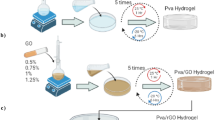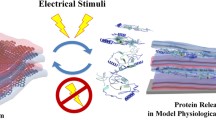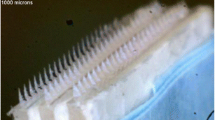Abstract
The environmental responsiveness of smart responsive gels under specific conditions has attracted great attention in recent years. In this paper, we have investigated the preparation of previously unreported electric field/temperature-sensitive three-dimensional graphene oxide hydrogels and their transdermal absorption studies, choosing indapamide (IND) as a model drug. Three-dimensional graphene oxide (3D@GO) has a unique three-dimensional network-like structure, excellent electrical properties, and mechanical properties. Three-dimensional graphene oxide network structures were prepared based on graphene oxide (GO) with the addition of formaldehyde, resorcinol, and sodium carbonate as reactants and catalysts. 3D@GO was compounded with a temperature-sensitive gel matrix, hydroxybutyl chitosan (HBC), to obtain a temperature-sensitive composite hydrogel with enhanced mechanical, electrical, and thermal properties. After applying 3D@GO–HBC to the skin, it can rapidly convert from liquid to semi-solid and adhere to the skin at the skin temperature. It can also be used as a carrier for controlled drug release under electric field conditions. This study of transdermal-controlled release drug delivery under electric field modulation showed that the cumulative release values of IND were 2.02 μg/cm2, 2.21 μg/cm2, 2.45 μg/cm2, 2.85 μg/cm2 , and 3.16 μg/cm2 in 24 h under the application of electric fields of 0 μA, 50 μA, 100 μA, 150 μA and 200 μA, respectively. The results indicated that 3D@GO–HBC hydrogels have good electrical sensitivity and can enhance the cumulative transdermal release of drugs under electric field conditions, providing an advantage not previously reported for controlled release of drugs.








Similar content being viewed by others
References
Y. Wang, C. Song, X. Yu, L. Liu, Y. Han, J. Chen, and J. Fu, Thermo-responsive hydrogels with tunable transition temperature crosslinked by multifunctional graphene oxide nanosheets. Compos. Sci. Technol. 151, 139 (2017).
W. Feng and Z. Wang, Shear-thinning and self-healing chitosan-graphene oxide hydrogel for hemostasis and wound healing. Carbohydr. Polym. 294, 119824 (2022).
L. Wu, J. Zhou, X. Bu, Y. Ge, Y. Gao, and X. Ma, Highly Stretchable, self-recoverable, and conductive double-network gels containing deep eutectic solvent for a flexible supercapacitor and strain sensor. J. Electron. Mater. 51(9), 5074 (2022).
J.Y. Li, Y.H. Feng, Y.T. He, L.F. Hu, L. Liang, Z.Q. Zhao, B.Z. Chen, and X.D. Guo, Thermosensitive hydrogel microneedles for controlled transdermal drug delivery. Acta Biomater. 153, 308 (2022).
H. Dai, R. Li, S. Su, Y. Cui, Y. Lin, L. Zhang, and X. Zhu, Preparation and characterization of PANI/MWCNT/RGO ternary composites as electrode materials for supercapacitors. J. Electron. Mater. 51(3), 1409 (2022).
L. Liu, Q. Gao, X. Lu, and H. Zhou, In situ forming hydrogels based on chitosan for drug delivery and tissue regeneration. Asian J. Pharm. Sci. 11(6), 673 (2016).
N. Jommanee, C. Chanthad, and K. Manokruang, Preparation of injectable hydrogels from temperature and pH responsive grafted chitosan with tuned gelation temperature suitable for tumor acidic environment. Carbohydr. Polym. 198, 486 (2018).
Z. Cao, C. Su, X. Sun, K. Shao, X. Wang, Y. Mu, X. Chen, and C. Feng, Enhanced mechanical properties of hydroxybutyl chitosan hydrogel through anchoring interface effects of diatom biosilica. Carbohydr. Polym. 296, 119975 (2022).
Q.Q. Wang, M. Kong, Y. An, Y. Liu, J.J. Li, X. Zhou, C. Feng, J. Li, S.Y. Jiang, X.J. Cheng, and X.G. Chen, Hydroxybutyl chitosan thermo-sensitive hydrogel: a potential drug delivery system. J. Mater. Sci. 48(16), 5614 (2013).
D. Qin, A. Zhang, N. Wang, Y. Yao, X. Chen, and Y. Liu, Hydroxybutyl chitosan/oxidized glucomannan self-healing hydrogels as BMSCs-derived exosomes carriers for advanced stretchable wounds. Appl. Mater. Today 26, 101342 (2022).
Z. Wan, Q. Dong, X. Guo, X. Bai, X. Zhang, P. Zhang, Y. Liu, L. Lv, and Y. Zhou, A dual-responsive polydopamine-modified hydroxybutyl chitosan hydrogel for sequential regulation of bone regeneration. Carbohydr. Polym. 297, 120027 (2022).
Y. Yun, H. Wu, J. Gao, W. Dai, L. Deng, O. Lv, and Y. Kong, Facile synthesis of Ca2+-crosslinked sodium alginate/graphene oxide hybrids as electro- and pH-responsive drug carrier. Mater. Sci. Eng. C 108, 110380 (2020).
T.T.P.N.X. Trinh, D.M. Nguyet, T.H. Quan, T.N.M. Anh, D.B. Thinh, L.T. Tai, N.T. Lan, D.N. Trinh, N.M. Dat, H.M. Nam, M.T. Phong, and N.H. Hieu, Preparing three-dimensional graphene aerogels by chemical reducing method: investigation of synthesis condition and optimization of adsorption capacity of organic dye. Surf. Interfaces 23, 101023 (2021).
M.Z. Ahmad, I.A. Bhatti, K. Qureshi, N. Ahmad, J. Nisar, M. Zuber, A. Ashar, M.I. Khan, and M. Iqbal, Graphene oxide supported Fe2(MoO4)3 nano rods assembled round-ball fabrication via hydrothermal route and photocatalytic degradation of nonsteroidal anti-inflammatory drug. J. Mol. Liquids 301, 112343 (2020).
W.-F. Lai and W.-T. Wong, Use of graphene-based materials as carriers of bioactive agents. Asian J. Pharm. Sci. 16(5), 577 (2021).
Y. Liang, Y. Liang, H. Zhang, and B. Guo, Antibacterial biomaterials for skin wound dressing. Asian J. Pharm. Sci. 17(3), 353 (2022).
Y. Hou, K. Sheng, Y. Lu, C. Ma, W. Liu, X. Men, L. Xu, S. Yin, B. Dong, X. Bai, and H. Song, Three-dimensional graphene oxide foams loaded with AuPd alloy: a sensitive electrochemical sensor for dopamine. Microchim. Acta 185(8), 397 (2018).
C. Zhang, J. Zeng, C. Xu, T. Gao, and X. Wang, Electric double layer capacitors based on porous three-dimensional graphene materials for energy storage. J. Electron. Mater. 50(6), 3043 (2021).
W. Zhang, X. Zhao, H. Wang, S. Fan, and S. Sun, Three-dimensional α-Fe2O3/graphene hydrogel composites as anode materials for high-performance asymmetric supercapacitors. J. Electron. Mater. 52(2), 925 (2023).
Y.C. Shin, S.H. Kang, J.H. Lee, B. Kim, S.W. Hong, and D.W. Han, Three-dimensional graphene oxide-coated polyurethane foams beneficial to myogenesis. J. Biomater. Sci. Polym. Ed. 29(7–9), 762 (2018).
S. Kim, S. Moriya, S. Maruki, T. Fukaminato, T. Ogata, and S. Kurihara, Adsorption and release on three-dimensional graphene oxide network structures. R. Soc. Open Sci. 8(5), 201585 (2021).
X. Zhou, S.C. Cui, and J.G. Liu, Three-dimensional graphene oxide cross-linked by benzidine as an efficient metal-free photocatalyst for hydrogen evolution. RSC Adv. 10(25), 14725 (2020).
D.M. Robinson and K. Wellington, Indapamide sustained release: a review of its use in the treatment of hypertension. Drugs 66(2), 257 (2006).
P.E. Grebow, J.A. Treitman, E.P. Barry, D.J. Blasucci, S.T. Portelli, N.C. Tantillo, R.A. Vukovich, and E.S. Neiss, Pharmacokinetics and bioavailability of indapamide–a new antihypertensive drug. Eur. J. Clin. Pharmacol. 22(4), 295 (1982).
C. Ren, L. Fang, L. Ling, Q. Wang, S. Liu, L. Zhao, and Z. He, Design and in vivo evaluation of an indapamide transdermal patch. Int. J. Pharm. 370(1–2), 129 (2009).
Acknowledgments
The study was supported by LiaoNing Revitalization Talents Prograrn (XLYC2007054) and the Liaoning Provincial Department of Education Program of China (Grant No. LJKZ0095).
Author information
Authors and Affiliations
Corresponding author
Ethics declarations
Conflict of interest
All data that support the findings of this study are included within the article (and any supplementary files). On behalf of all authors, the corresponding author states that there is no conflict of interest.
Additional information
Publisher's Note
Springer Nature remains neutral with regard to jurisdictional claims in published maps and institutional affiliations.
Rights and permissions
Springer Nature or its licensor (e.g. a society or other partner) holds exclusive rights to this article under a publishing agreement with the author(s) or other rightsholder(s); author self-archiving of the accepted manuscript version of this article is solely governed by the terms of such publishing agreement and applicable law.
About this article
Cite this article
Jia, K., Chen, A., Dong, M. et al. Preparation of Three-Dimensional Graphene Oxide Electric-Field/Temperature-Sensitive Hydrogels and Transdermal-Controlled Release Drug Delivery Study. J. Electron. Mater. 52, 3374–3385 (2023). https://doi.org/10.1007/s11664-023-10307-y
Received:
Accepted:
Published:
Issue Date:
DOI: https://doi.org/10.1007/s11664-023-10307-y




